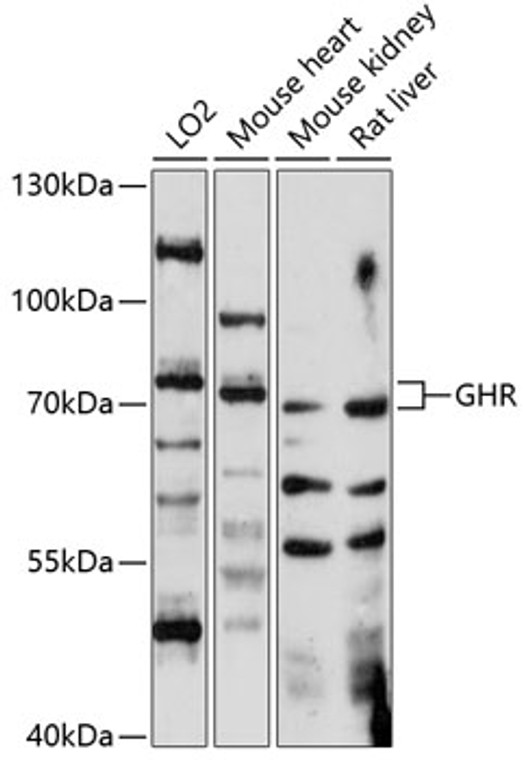| Host: |
Rabbit |
| Applications: |
WB |
| Reactivity: |
Human/Mouse/Rat |
| Note: |
STRICTLY FOR FURTHER SCIENTIFIC RESEARCH USE ONLY (RUO). MUST NOT TO BE USED IN DIAGNOSTIC OR THERAPEUTIC APPLICATIONS. |
| Short Description: |
Rabbit polyclonal antibody anti-GHR (26-260) is suitable for use in Western Blot research applications. |
| Clonality: |
Polyclonal |
| Conjugation: |
Unconjugated |
| Isotype: |
IgG |
| Formulation: |
PBS with 0.01% Thimerosal, 50% Glycerol, pH7.3. |
| Purification: |
Affinity purification |
| Dilution Range: |
WB 1:500-1:2000 |
| Storage Instruction: |
Store at-20°C for up to 1 year from the date of receipt, and avoid repeat freeze-thaw cycles. |
| Gene Symbol: |
GHR |
| Gene ID: |
2690 |
| Uniprot ID: |
GHR_HUMAN |
| Immunogen Region: |
26-260 |
| Immunogen: |
Recombinant fusion protein containing a sequence corresponding to amino acids 26-260 of human GHR (NP_001229328.1). |
| Immunogen Sequence: |
FSGSEATAAILSRAPWSLQS VNPGLKTNSSKEPKFTKCRS PERETFSCHWTDEVHHGTKN LGPIQLFYTRRNTQEWTQEW KECPDYVSAGENSCYFNSSF TSIWIPYCIKLTSNGGTVDE KCFSVDEIVQPDPPIALNWT LLNVSLTGIHADIQVRWEAP RNADIQKGWMVLEYELQYKE VNETKWKMMDPILTTSVPVY SLKVDKEYEVRVRSKQRNSG NYGEFSEVLYVTLPQ |
| Tissue Specificity | Expressed in various tissues with high expression in liver and skeletal muscle. Isoform 4 is predominantly expressed in kidney, bladder, adrenal gland and brain stem. Isoform 1 expression in placenta is predominant in chorion and decidua. Isoform 4 is highly expressed in placental villi. Isoform 2 is expressed in lung, stomach and muscle. Low levels in liver. |
| Post Translational Modifications | The soluble form (GHBP) is produced by phorbol ester-promoted proteolytic cleavage at the cell surface (shedding) by ADAM17/TACE. Shedding is inhibited by growth hormone (GH) binding to the receptor probably due to a conformational change in GHR rendering the receptor inaccessible to ADAM17. On GH binding, phosphorylated on tyrosine residues in the cytoplasmic domain by JAK2. On ligand binding, ubiquitinated on lysine residues in the cytoplasmic domain. This ubiquitination is not sufficient for GHR internalization. |
| Function | Receptor for pituitary gland growth hormone involved in regulating postnatal body growth. On ligand binding, couples to the JAK2/STAT5 pathway. The soluble form (GHBP) acts as a reservoir of growth hormone in plasma and may be a modulator/inhibitor of GH signaling. Isoform 2 up-regulates the production of GHBP and acts as a negative inhibitor of GH signaling. |
| Protein Name | Growth Hormone ReceptorGh ReceptorSomatotropin Receptor Cleaved Into - Growth Hormone-Binding ProteinGh-Binding ProteinGhbpSerum-Binding Protein |
| Database Links | Reactome: R-HSA-1170546Reactome: R-HSA-982772 |
| Cellular Localisation | Cell MembraneSingle-Pass Type I Membrane ProteinOn Growth Hormone BindingGhr Is UbiquitinatedInternalizedDown-Regulated And Transported Into A Degradative Or Non-Degradative PathwayIsoform 2: Cell MembraneRemains Fixed To The Cell Membrane And Is Not InternalizedGrowth Hormone-Binding Protein: SecretedComplexed To A Substantial Fraction Of Circulating Gh |
| Alternative Antibody Names | Anti-Growth Hormone Receptor antibodyAnti-Gh Receptor antibodyAnti-Somatotropin Receptor Cleaved Into - Growth Hormone-Binding Protein antibodyAnti-Gh-Binding Protein antibodyAnti-Ghbp antibodyAnti-Serum-Binding Protein antibodyAnti-GHR antibody |
Information sourced from Uniprot.org
12 months for antibodies. 6 months for ELISA Kits. Please see website T&Cs for further guidance







